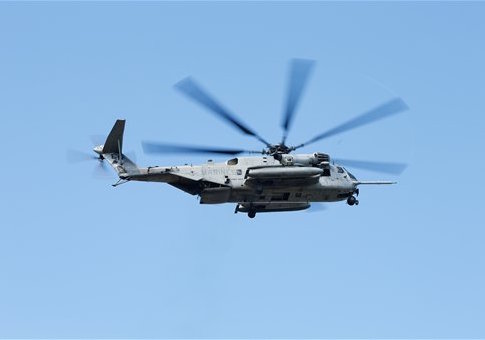The deadly helicopter crash that killed 12 Marines off the coast of Oahu earlier this year was a result of pilot error, a lack of training, and command problems, according to a Marine investigation into the incident.
The investigation, which was obtained by the Investigative Reporting Program at the University of California, Berkeley, and reported by Civil Beat and the Huffington Post, found that the pilots of the two CH-53E Super Stallion helicopters had not met service goals for flight hours in the month leading up to the crash.
The helicopters, which were each carrying six crew members, crashed off the coast of Oahu's Waimea Bay around 11 p.m. on January 14 while conducting a nighttime tactical formation flight. All 12 Marines aboard the aircraft were killed "instantaneously," according to the investigation, in a crash that yielded an explosion with forces "estimated at hundreds of times the force of gravity."
The Marine Corps declared all 12 service members dead after five days of unsuccessful search and rescue operations in January.
Service officials said in a statement Tuesday that "low aircraft readiness leading to inadequate pilot efficiency, human factors, and the squadron's lack of focus on basic aviation practices" were the main causes of the crash.
According to the investigation, the four pilots had logged "4, 5, 4, and 13 hours" of flight time in the 30 days before the incident, which are all less than the Marine's 15.1 flight hours per month goal for the Super Stallion helicopters. The months-long probe also concluded that two of the pilots were not "adequately proficient" in using night vision devices.
There was no evidence that either of the helicopters endured mechanical problems leading up to the incident.
The Marines were part of the Marine Heavy Helicopter Squadron 463 based at Kaneohe Bay. According to investigators, several of the pilots in the squadron were worried about not logging enough flight training hours the month that the crash occurred.
The probe also found that the firing of the commanding officer of the squadron days before the crash disrupted the "daily routine" and served as a "distraction." He was fired, in part, because of a loss of confidence largely due to his "inability to improve aircraft readiness."
Marine aviation deaths reached a five-year high months before the January crash, 18 Marines having died in 13 separate incidents between May 2014 and September 2015. A Senate committee convened a hearing in March to ask Gen. Robert Neller, the Marine commandant, whether budget reductions had contributed to the increase in fatal helicopter crashes.
"I would say the CH-53 community is probably right now the most challenged because of a variety of reasons: available aircraft, certain maintenance issues that go back to a Navy MH-53 accident three years ago this past January," Neller told lawmakers. "When you don't have enough airplanes to fly, then your flying hours go down and it becomes difficult to maintain your currency."
Budget cuts and force reductions have placed stresses on all of the military services, prompting leaders to voice concerns about impacts on readiness. Budget cuts coupled with continued deployments have generally reduced the services' number of aircraft available to fly, resulting in less flying time for pilots.
